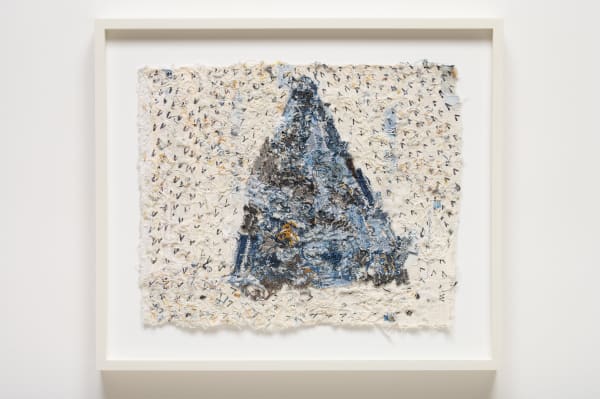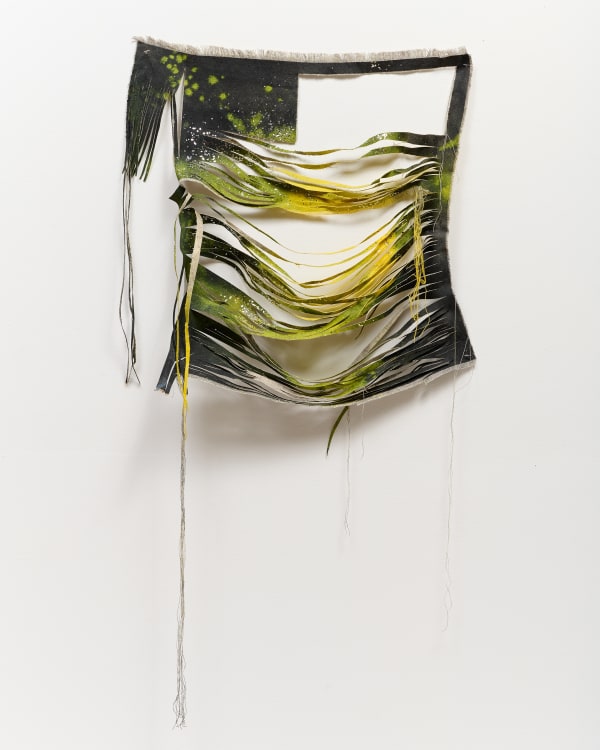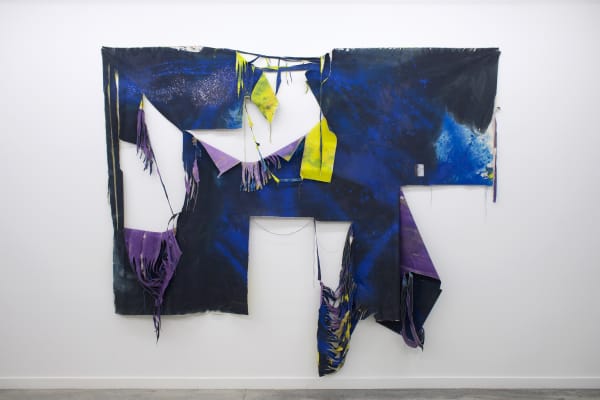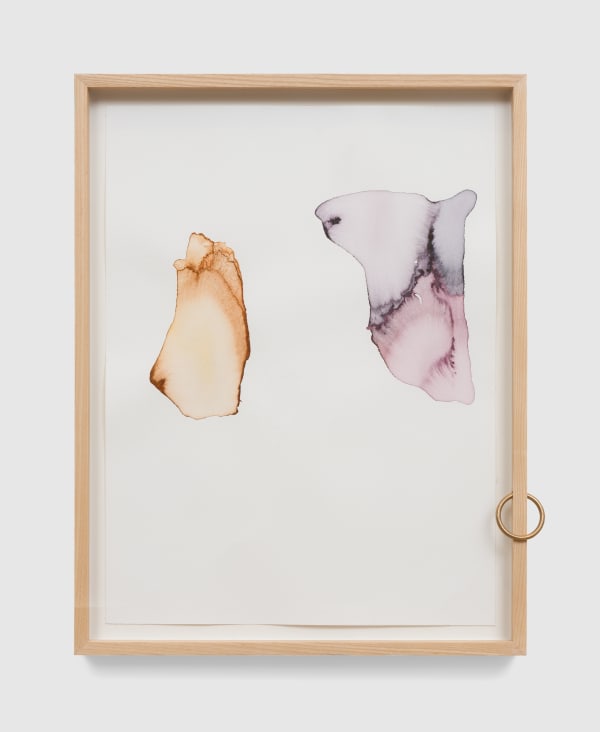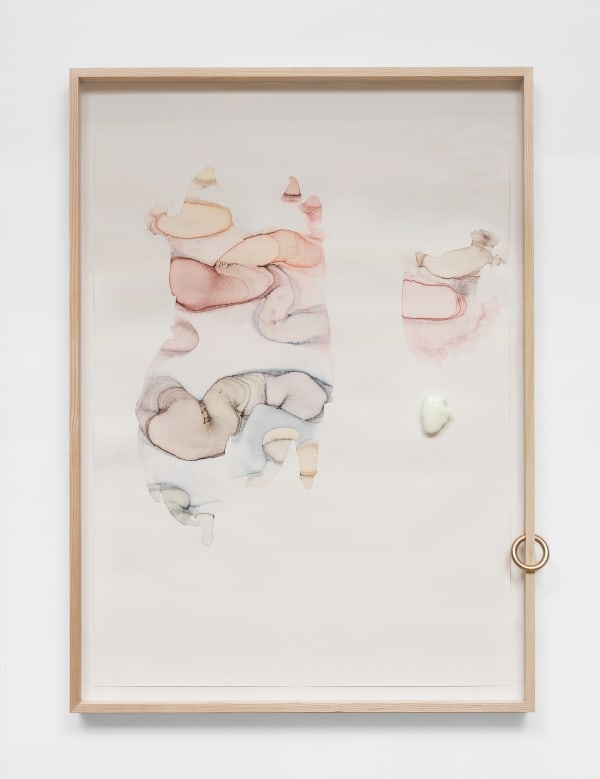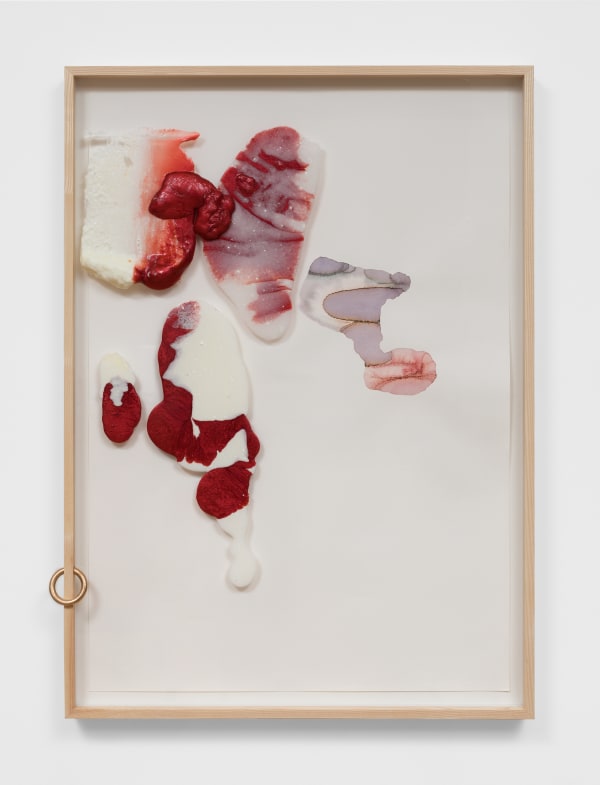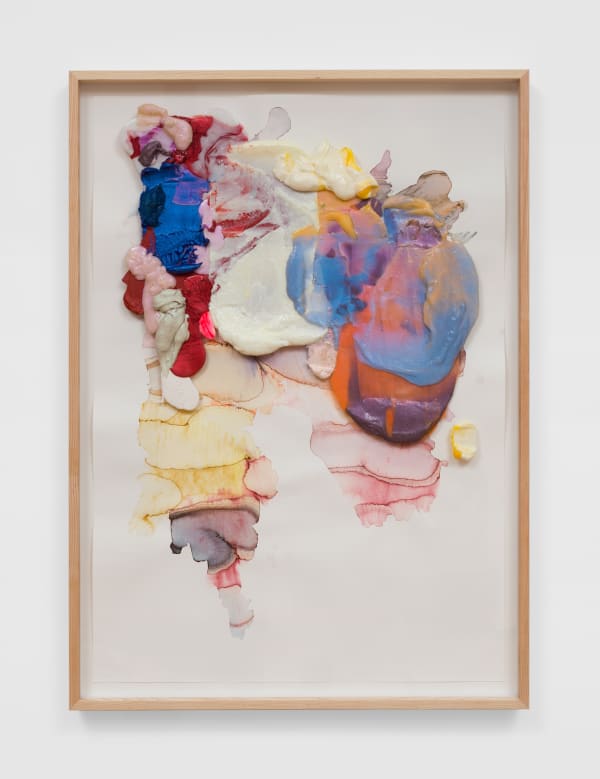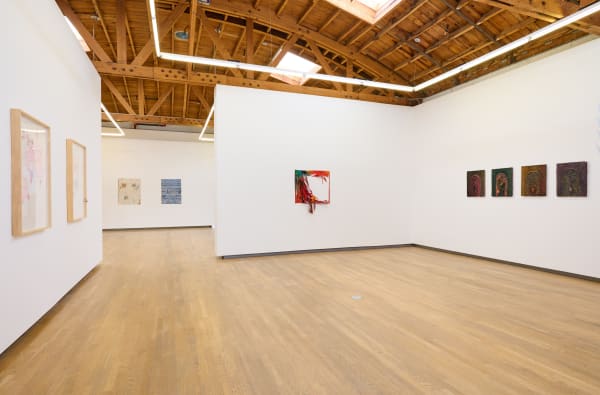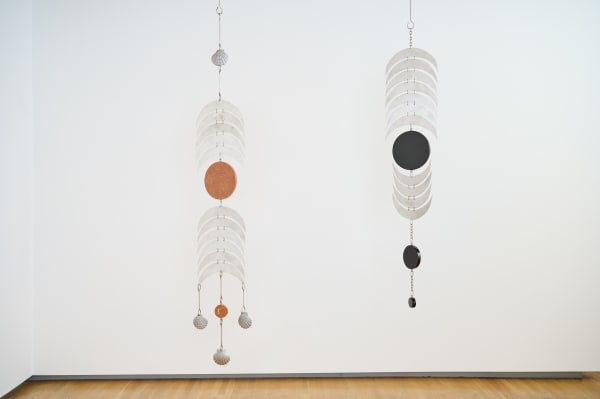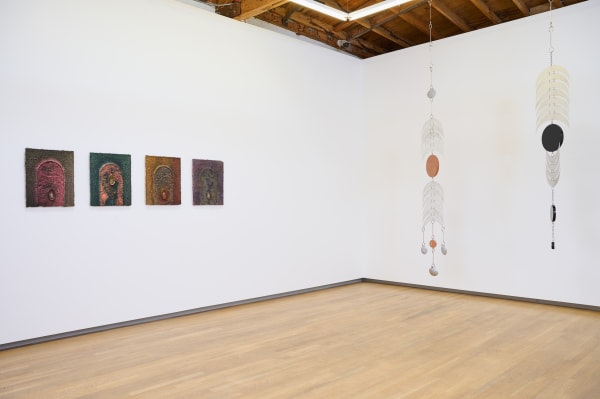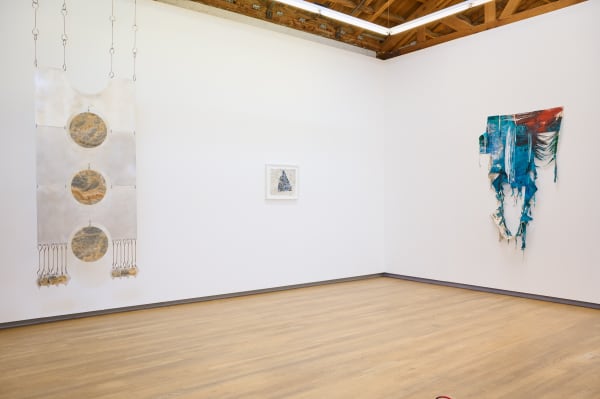Material Matters: Jamal Cyrus, Vaughn Davis Jr., Aryana Minai, Fay Ray, and Tori Wrånes
Nazarian / Curcio is pleased to announce Material Matters, a group exhibition featuring works by Jamal Cyrus, Vaughn Davis Jr., Aryana Minai, Fay Ray, and Tori Wrånes. These artists are united through their use of abstraction and materiality as a means to explore personal narrative, address pertinent political histories, and deal with issues of labor, migration, the body, and memory. Employing a wide range of media, including denim, metal, stone, silicon, paper-pulp, and shredded canvas, each artist’s respective material is coded with specific meaning and utilizes the language of abstraction to create nuanced and provocative narratives that speak to lived experience.
Jamal Cyrus is a Houston-based artist whose expansive practice encompasses collage, assemblage, and conceptual sculpture to explore the African diaspora, particularly the symbioses between Black political movements and spiritual struggles. Since 2019, the artist has worked with denim as a raw material, transforming used jeans into painterly abstractions. Cyrus states that these works, “use the materials and format of the quilt to document aspects of Black political history.” Whether mining FBI memorandums surveilling Black activists and artists or shedding light on underknown corners of the Black American experience, Cyrus’ practice acknowledges how hardship and tragedy function to fuel hope, resistance, and progress within Black American culture, presenting the viewer with an expanded understanding of American history.
The large-scale suspended and wall-based sculptures of Los Angeles-based Fay Ray explore her familial and religious roots via notions of female identity, labor, migration, and the cultural fetishization of objects. Often returning to the High Desert in Southern California where she spent her formative years, Ray collects a variety of natural and manmade materials such as cast aluminum, weathered steel sheeting, stone, ceramics, wire and chain. Through these materials, the artist conflates faith and desire, borrowing from the symbols and compositions of traditional religious relics and the visual language of the occult. In addition to the California desert’s relationship to migration and labor, Ray also looks to the materials of the desert landscape for their symbolic relation to femininity, fertility, and motherhood, evoking a continually materializing body through abstract form.
St. Louis-based Vaughn Davis Jr.’s works on canvas challenge the boundaries of painting, performance, and sculpture. Ranging in scale from intimate to monumental, Davis’ expressive paintings, pinned directly to the wall, are freed from the traditional support of stretcher bars, allowing their form to be configured into various shapes through draping and folding. Davis engages with both acts of creation and destruction, soaking his canvases in pigment and then cutting, ripping and fraying the fabric in search of new compositions. For Davis, the physical act of making the work serves as a metaphor for his own lived experience as well as that of the Black and Brown communities around him. Davis has reflected on his works as, “objects of madness [that] hang in their own identity . . . [having] inherited chaos through their occupation in this time.”
Los Angeles-based artist Aryana Minai’s paper-based wall reliefs link philosophies and histories of architecture, migration, labor, and the body with the handmade. Unlike past works, in which the paper pulp was dyed directly, the three new pieces on view are colored through the offset absorption of pigment from stained drop cloths, which were used in the making of previous works. This new process introduces a softer palette of whites, pinks, and blues, while calling on the memory of past works to form new ones. Minai employs paper as a material that embodies storytelling, tradition, and craft. Drawing from a personal archive of memories from growing up between Iran and the U.S., Minai creates richly textured patterns in the paper-pulp surfaces of her work, using bricks and stones from buildings that no longer exist, woodblocks that are a generation old, parts of vernacular decorative architecture, and traces of her fingertips. She envisions architecture as a living entity that continually sheds and acquires memories as bodies pass through its spaces. Minai’s work speaks to the details that define a place in our mind when we are no longer there, and these works in particular serve as a homage to her childhood bedroom in Iran, memorializing this sacred space of her youth as her memories of it fade over time.
One of Norway’s most celebrated artists, Oslo-based Tori Wrånes is known for intricate installations, large-scale sculpture, and highly choreographed performances that combine sound, elaborate costuming, and uncanny prosthetics. Wrånes’ practice involves fantastical interpretations of queer identity, Nordic folklore, and the natural world. Her sculptures often evoke the body without fully representing it, while her action-based abstract paintings are composed of the same silicon and pigment that forms the prosthetics of her costumes. On view are five recent framed works featuring organic forms that appear to grow gently on the paper’s surface. These delicately rendered paintings are even more bodily when coated in a skin-like silicon or when the artist pierces the frame’s edge, humanized by being physically penetrated with the jewelry’s metal rings.
-
 Jamal CyrusD's Precognitive Notes on the General Strike, 2024
Jamal CyrusD's Precognitive Notes on the General Strike, 2024 -
 Jamal CyrusTri-Ambulations, 2024
Jamal CyrusTri-Ambulations, 2024 -
 Jamal CyrusDeep River Passage, 2024
Jamal CyrusDeep River Passage, 2024 -
 Vaughn Davis, Jr.Blues in the Figure, 2023
Vaughn Davis, Jr.Blues in the Figure, 2023 -
 Vaughn Davis, Jr.Untitled, 2024
Vaughn Davis, Jr.Untitled, 2024 -
 Vaughn Davis, Jr.Gone without a trace, 2024
Vaughn Davis, Jr.Gone without a trace, 2024 -
 Vaughn Davis, Jr.Our memories lost in the fugue, 2023
Vaughn Davis, Jr.Our memories lost in the fugue, 2023 -
 Aryana MinaiLike the Back of One's Hand, 2024
Aryana MinaiLike the Back of One's Hand, 2024 -
 Aryana MinaiResplendently Blooming, 2024
Aryana MinaiResplendently Blooming, 2024 -
 Aryana MinaiEchos and Minglings, 2024
Aryana MinaiEchos and Minglings, 2024 -
 Aryana MinaiLife Forms XI, 2023
Aryana MinaiLife Forms XI, 2023 -
 Aryana MinaiLife Forms IX, 2023
Aryana MinaiLife Forms IX, 2023 -
 Aryana MinaiLife Forms X, 2023
Aryana MinaiLife Forms X, 2023 -
 Aryana MinaiLife Forms XII, 2023
Aryana MinaiLife Forms XII, 2023 -
 Fay RayPosidonia, 2023
Fay RayPosidonia, 2023 -
 Fay RayRed Matrix, 2024
Fay RayRed Matrix, 2024 -
 Fay RayBlack Matrix, 2024
Fay RayBlack Matrix, 2024 -
 Tori WrånesMothers and Child (Garden) , 2022
Tori WrånesMothers and Child (Garden) , 2022 -

-
 Tori WrånesGarden, 2022
Tori WrånesGarden, 2022 -
 Tori WrånesGarden, 2022
Tori WrånesGarden, 2022 -
 Tori WrånesGarden, 2022
Tori WrånesGarden, 2022
-
 Material Matters, July 27- August 31, 2024.
Material Matters, July 27- August 31, 2024. -
 Material Matters, July 27- August 31, 2024.
Material Matters, July 27- August 31, 2024. -
 Material Matters, July 27- August 31, 2024.
Material Matters, July 27- August 31, 2024. -
 Material Matters, July 27- August 31, 2024.
Material Matters, July 27- August 31, 2024. -
 Material Matters, July 27- August 31, 2024.
Material Matters, July 27- August 31, 2024. -
 Material Matters, July 27- August 31, 2024.
Material Matters, July 27- August 31, 2024. -
 Material Matters, July 27- August 31, 2024.
Material Matters, July 27- August 31, 2024. -
 Material Matters, July 27- August 31, 2024.
Material Matters, July 27- August 31, 2024. -
 Material Matters, July 27- August 31, 2024.
Material Matters, July 27- August 31, 2024. -
 Material Matters, July 27- August 31, 2024.
Material Matters, July 27- August 31, 2024. -
 Material Matters, July 27- August 31, 2024.
Material Matters, July 27- August 31, 2024. -
 Material Matters, July 27- August 31, 2024.
Material Matters, July 27- August 31, 2024. -
 Material Matters, July 27- August 31, 2024.
Material Matters, July 27- August 31, 2024.


